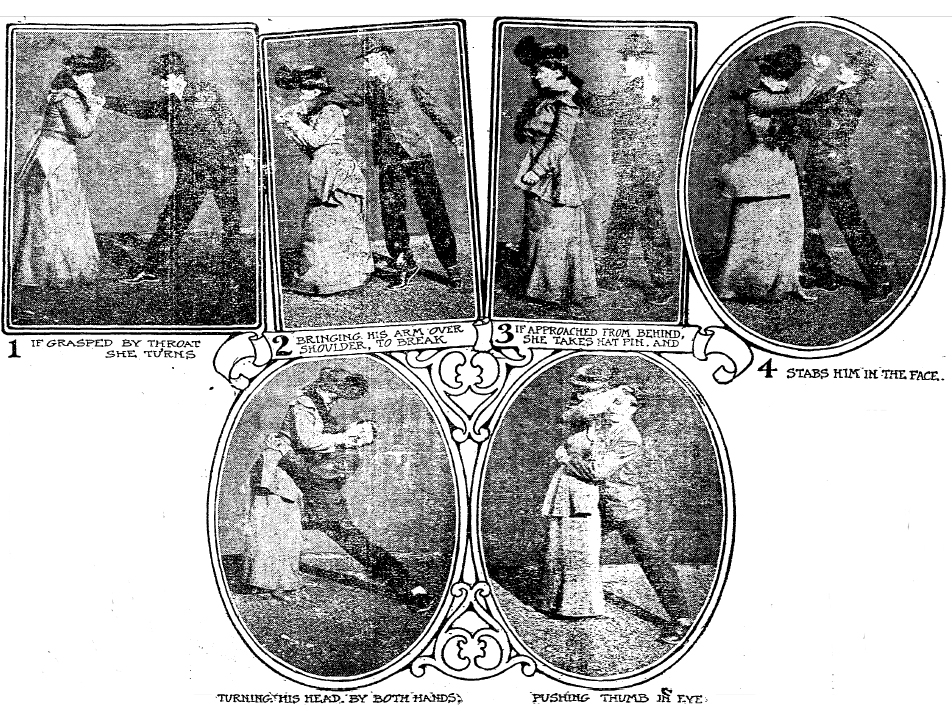- Originally published on the Bartitsu.org site on Saturday, 20th April 2013
Thanks to Maxime Chouinard for forwarding this item.
Please click on the picture below to view it at full size.
Mlle. Gelas Shows Audience Tricks by Which a Woman Can Repel Attacks of a Ruffian with Hatpin or Twist to Break Arm or Upset Him
A Woman’s Art of Self Defence
Mlle. Gelas’ Demonstration of a Forearm Twist Which Will Break the Bone or Upset a Ruffian
HATPIN NOT HER ONLY WEAPON
Little Strength, Properly Applied, Is Wonderfully Effective
Tricks Men Can Employ
The ease and certainty with which a young woman may defend herself from attacks by ruffians or highway robbers was demonstrated by Mlle. Marie Gelas before an audience which comfortably filled Association Hall last night.
Prof. J.M. Gelas Sr. and Prof. J.M. Gelas Jr. gave an exposition of their system of self-defence, and the demonstration was as novel as it was entertaining.
The program was an exhibition of the art of self-defence given by the Gelas family, assisted by Capt. Seaholme, A.G. Adams and H.H. Davis. There were many interesting bouts with foils, fencing swords and single-sticks, in the handling of which Prof. Gelas and his son are masters, but the number of absorbing interest was Mlle. Gelas’ illustration of the ease with which unexpected attacks may be repelled by the young woman who has a bit of knowledge of the proper manner of going about it, coupled with a bit of presence of mind.
Mlle. Gelas was assisted by her brother, Prof. J.M. Gelas, Jr., and effectively repelled every manner of attack with the employment of no more force than is possessed by the average woman. One or two of her methods of meeting attacks were effective enough, if employed with only ordinary force, to leave a street ruffian either absolutely powerless or writhing in agony. In one or two of her demonstrations, Mlle. Gelas made use of the ever-present feminine hat-pin and an umbrella, but just as efficient were the methods to repel attack with little strength properly and quickly applied.
Seized by the throat by her brother, as they met each other, Mlle. Gelas seized his wrist with both hands and, with a quick outward turn, the young woman whirled her supposed assailant with leverage enough to throw him upon his back or to break his arms if he struggled. This is perhaps the only one of the demonstrations which resembled the Japanese system.
Taken again by the throat by the imaginary ruffian, Mlle. Gelas seized his wrist with a sudden jerk and, turning suddenly and drawing the arm over her shoulder for a fulcrum, bore down upon the wrist with leverage enough to snap the bone, with the exertion of a little force.
The young woman, in a dozen different movements, showed the simple method of extending the arm and planting the first and second fingers of the hand in the eyes of her assailant, to the more complex moves by which an attack from the rear is rendered harmless, showing that while the hatpin and umbrella may be used commandingly at times, they are by no means necessary. The only weapons a young woman needs when seized hold of, according to Mlle. Gelas, are a ready wit and the knowledge of what to do at the proper moment.
Prof. Gelas and his son demonstrated how east it is to render the assailant powerless by the use of the simplest devices and a proper application of strength. The exhibition included illustrations of the proper employment of hat and cane, whether that attack be with a slungshot, a cane, knife or even a revolver thrust into the face within reach.
Other entertaining numbers on the programme were bouts with foils between Prof. Gelas and Capt. Seaholme, a fencing bout between A.G. Adams and H.H. Davis, both pupils of Prof. Gelas, and sword, foil and singlestick bouts between the Gelases, father and son.
Addendum: although little more is currently known about the Gelas method of self defence, it’s worth noting that Mlle. Marie Gelas bears a marked resemblance to the unidentified woman demonstrating umbrella self defence in these pictures, which were apparently taken at the Philadelphia Institute of Physical Culture in 1908:


